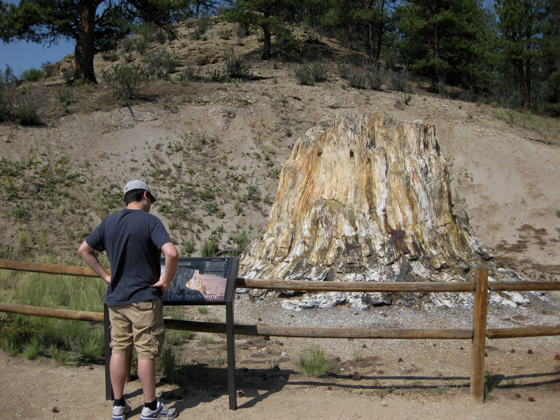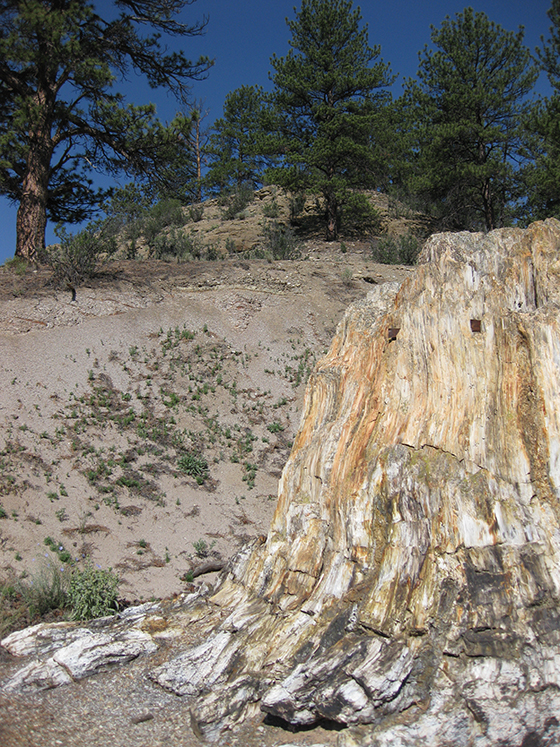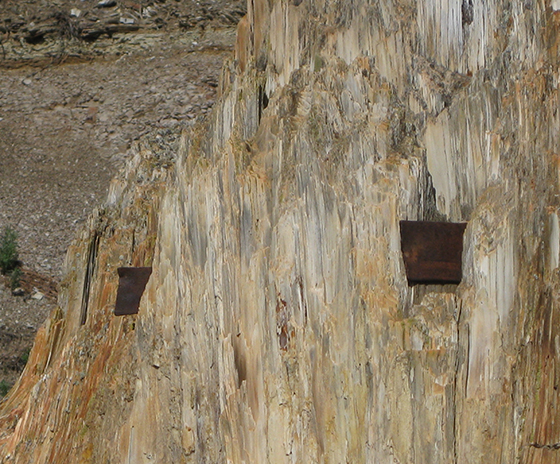
 |
 |
Florissant
Fossil Beds National Monument
Florissant,
Colorado: An Ancient Ecosystem Revealed by a Fossil Lagerstätten |
The Florissant fossil flora seems to have grown in an upland environment. The equable climate was most likely warm temperate with an MAT of 12-14 degrees Celsius and an annual precipitation of 50 to 80 cm of annual rainfall (Meyer, 2003, p. 52). Growth rings on fossil trees and laminated shales record the seasonality of this climate. Rainfall came mostly in the spring and summer months with winters that were mild but dry. Plants living near streams and lakes are more likely to be represented as fossils in the sedimentary deposits than those living in drier environments farther away. However, considering the relative abundance of fossil pollen and plants along with the preferred environments of their nearest living relatives one can make inferences about the patterns of vegetation across this ancient landscape (Meyer, 2003, p. 53). Algae, free-floating
water ferns (Azolla), water lilies in
the family Nymphaeaceae, cat-tails (Typha), and pondweed
(Potamogeton)
indicate a freshwater lake with marshy areas near the shoreline.
Fossil leaves and pollen suggest a carpet of deciduous forests
surrounding the lakeside and in valley bottoms along riparian
zones bordering streams. Beech (Fagopsis), Cedrelospermum,
Poplar (Populus), Willow (Salix), Sequoia,
and White Cedar or false cypress (Chamaecyparis) trees
would be found in these forests near water sources. Smaller
trees and shrubs made up
the understory of these lush forests including hickory (Carya),
maple (Acer), soapberry (Sapindus), raintree
(Koelruteria),
and Paracarpinus. Epiphytes in these forests included
the ferns Lygodium and Selaginella and possibly monocot bromeliads.
Forests
growing in this basin were humid and damp during the summer.
A transition zone between moist forests in the basin and those
growing in drier areas along ridges and hills may have been
populated by shrubs such as sumac (Rhus), Rosa, serviceberry
(Amelanchier), current (Ribes), and bladdernut (Staphylea).
Plants such as Mormon tea (Ephedra) and members of the family
Amaranthaceae which are drought and salt tolerant plants suggest
the existence of salty microenvironments. The upland woodland
areas above the Sequoia and deciduous forest were dryer and
composed of montane elements such as Pine (Pinus) and Oak (Quercus).
Spruce (Picea) and Fir (Abies) most likely occupied cool forest
pockets in the draws or The life cycles of insects also provide clues to the mosaic of microhabitats that may have existed at Florissant during this time. Dragonfly larvae are often found inhabiting water with vegetation such as cattails, while many caddisfly larvae flourish in streams littered with pebbles. The life cycle of butterflies and bees is completed in terrestrial environments and their presence suggests open areas such as meadows (Meyer, 2003, p. 54). The great diversity of fossils found at Florissant give insights into a mosaic of probable microenvironments found from an ancient lake to the surrounding hills of a volcano. To a casual observer many of the insects, arachnids, fish, birds, and plants making up the ancient Florissant ecosystem would have looked familiar. Spiders, mayflies, dragonflies, damselflies, ants, termites, flies, beetles, bees, wasps, and butterflies would have looked somewhat familiar. But even the casual observer would be taken aback by the beautiful spoon-winged lacewing Marquettia americana and the large tsete flies whose living relatives are now restricted to the tropics. So too, the rain tree Koelreuteria and tree of heaven Ailanthus whose living relatives are found only in southeast Asia might capture attention. These American “castaways” would have looked out of place. Even the casual observer would be shocked to see the now extinct mammalian fauna including oreodonts, brontotheres, and the three-toed horse Mesohippus. It is through the hard work of geologists and paleontologists that we gain an insight into casts of characters who interacted within these ancient lake and river ecosystems. The fossil record affords only pieces of the past. Science uses these pieces to work out a puzzle using a system of independent empirical verification. Together, impressions of the past explored by this most important human epistemology work out to be a way for nature to remember itself. Imagination fueled by empirical evidence is a true joy of science! Conclusion |
Acknowledgments I wish to thank Dr. Meyer for sharing his in-depth knowledge of Florissant Fossil Beds National Monument and for his feedback on earlier versions of this article. I would also like to thank Dr. Boyle for his suggestions on how to conceptualize his work on taxonomic calibration. Finally, I would like to thank Don Viney and Thomas Viney for their editing expertise. |
 Thomas Viney reads about the iconic "Big Stump" |
| Two pictures zoom in on pieces of broken, rusted saw blades embedded in the "Big Stump". These artifacts record an attempt to remove the Big Stump in small sections over 100 years ago. The Big Stump is estimated to weigh over 60 metric tons. There was interest in displaying a Florissant stump at the United States Centennial Exhibition of 1876 and the World’s Columbian Exposition of 1893 (Meyer, 2003, pp. 7 & 8). |
 |
 |
Bibliography |
| Leopold,
E.B. and Clay-Poole, S.T. (2001). Fossil leaf and pollen
floras of Colorado compared: climatic implications.
In Evanoff, E., Gregory-Wodzicki K.M. and Johnson,
K.R. [Eds.] Fossil Flora and Stratigraphy of the
Florissant Formation, Colorado. (pp. 17-55). Proceedings
of the Denver Museum of Nature and Science, series
4, number 1. Meyer, H.W. (2003). The Fossils of Florissant. Washington: Smithsonian Books. Nudds, J.R. & Selden, P.A. (2008). Fossil Ecosystems of North America: A Guide to the Sites and Their Extraordinary Biotas. Chicago: The University of Chicago Press. |










